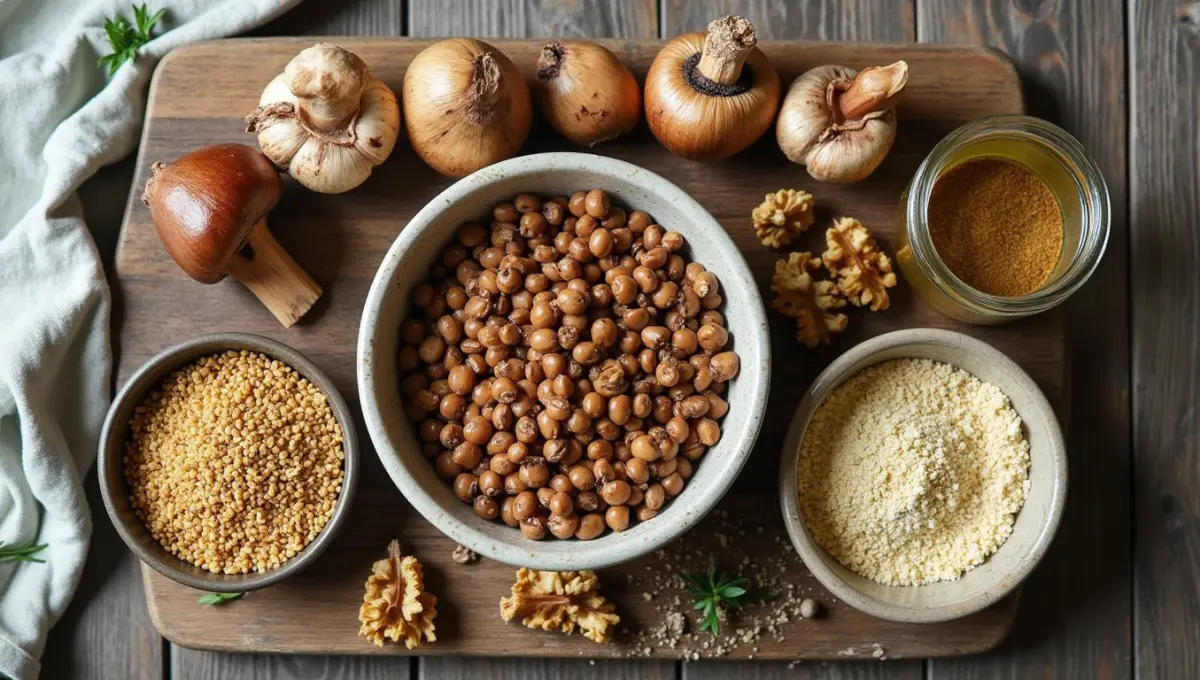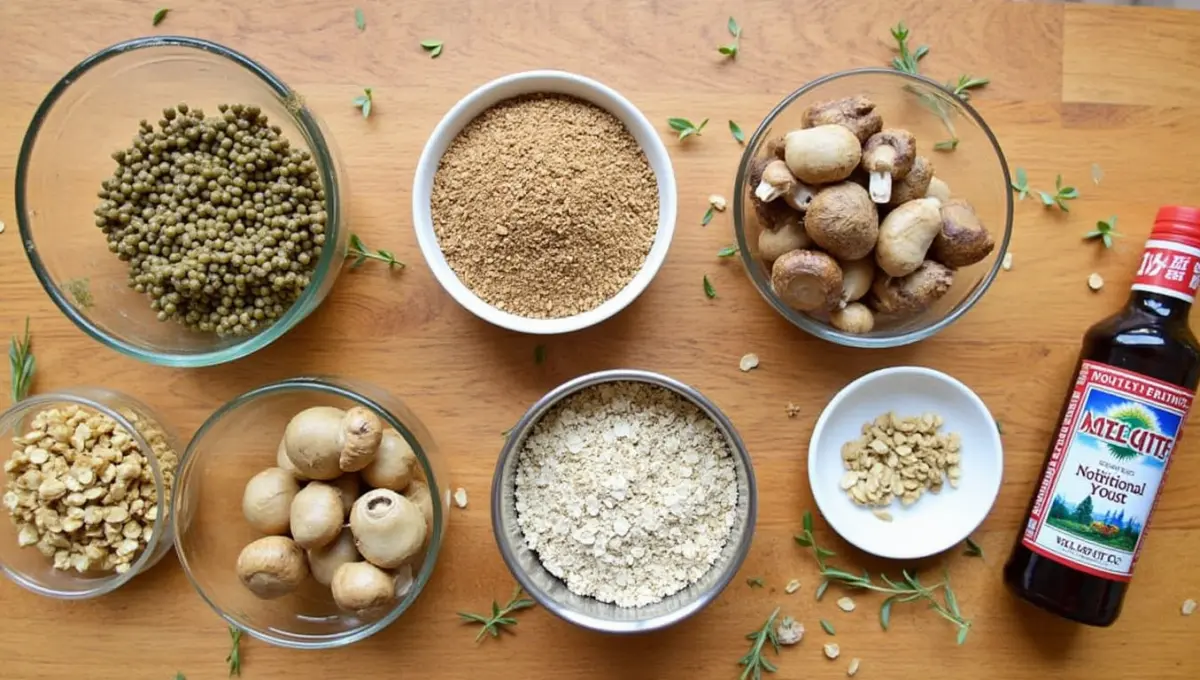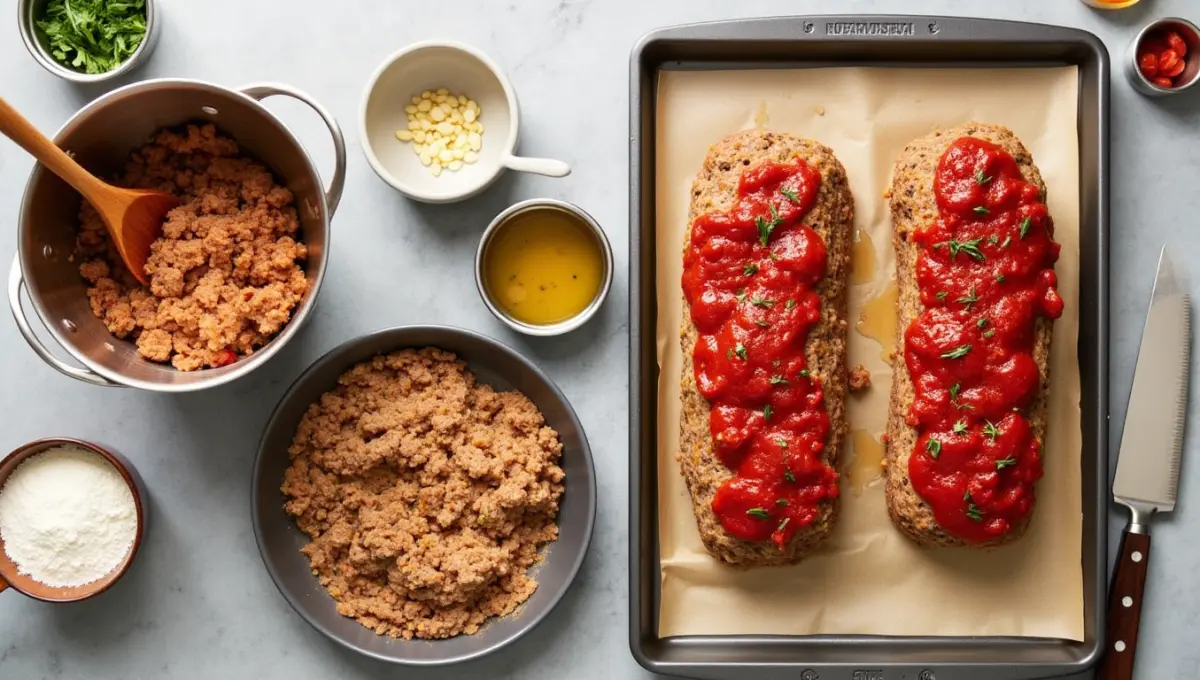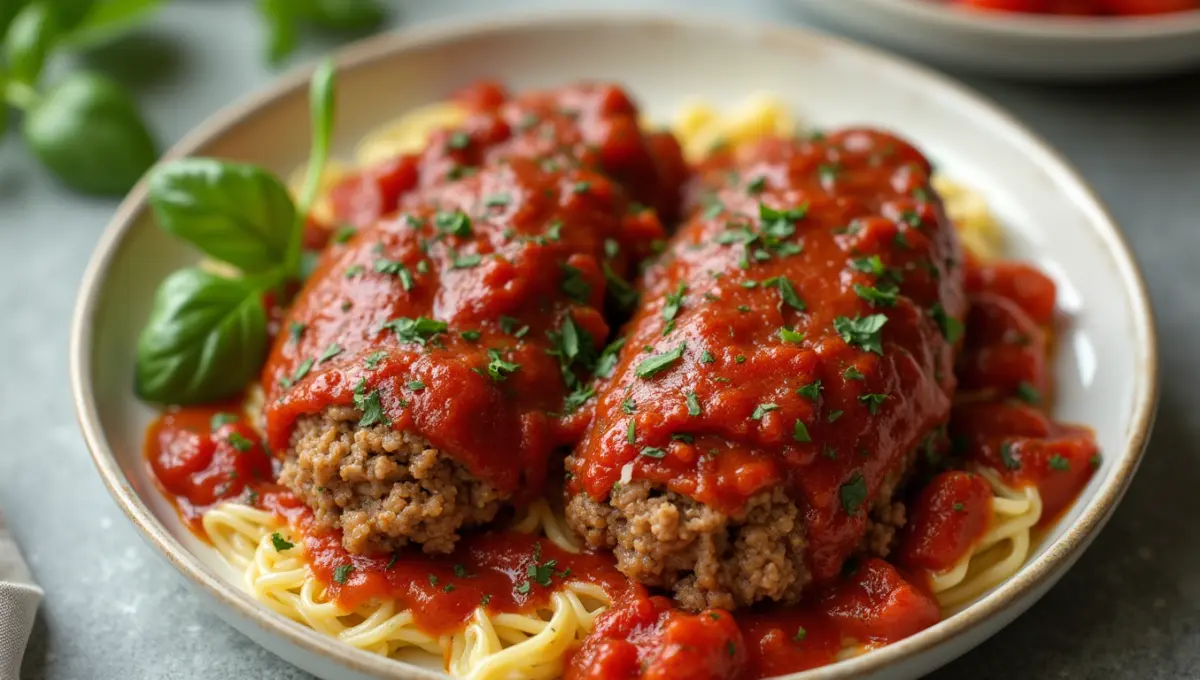Table of Contents
ToggleItalian meatloaf is a classic comfort food known for its rich flavors, hearty texture, and savory blend of ground meat, breadcrumbs, eggs, and Italian seasoning. Traditionally, it’s baked to perfection and topped with a flavorful tomato sauce, making it a staple in many households.
However, with the growing demand for plant-based alternatives, transforming this dish into a meat-free masterpiece has never been easier. Whether you’re looking for a healthier option, trying to reduce meat consumption, or following a vegan diet, there are simple swaps that allow you to enjoy the same satisfying taste and texture—without any animal products.
This Italian Meatloaf Recipe is completely plant-based and uses simple swaps for a delicious, healthy meal. By replacing traditional ingredients with plant-based alternatives like lentils, mushrooms, and flaxseed, you can create a dish that’s protein-packed, fiber-rich, and full of Italian flavors. In this recipe, we’ll explore seven surprisingly easy swaps that make this meatloaf just as hearty and flavorful as the original—without the meat!
Why Make a Vegan Italian Meatloaf?
1. Health Benefits of Plant-Based Meatloaf
A traditional meatloaf is typically high in saturated fat and cholesterol, which can contribute to heart disease and other health concerns. By contrast, this Italian Meatloaf Recipe is completely plant-based, making it a cholesterol-free option that’s packed with essential nutrients.
High in Protein – Ingredients like lentils, chickpeas, and walnuts provide a protein-rich base that supports muscle health and overall well-being. Try a protein pudding recipe for a sweet follow-up!
Fiber-Rich for Better Digestion – Unlike meat-based versions, plant-based meatloaf is naturally high in fiber, which aids digestion, promotes gut health, and helps maintain steady blood sugar levels.
Lower in Saturated Fat – Swapping out animal products for plant-based alternatives reduces unhealthy fats while still providing plenty of flavor and texture.
2. Sustainability and Ethical Benefits
Choosing a plant-based Italian meatloaf is also a more environmentally friendly choice. The production of lentils, mushrooms, and walnuts requires significantly fewer natural resources compared to beef or pork.
Lower Carbon Footprint – Plant-based ingredients generate fewer greenhouse gas emissions than traditional meat.
Water Conservation – Producing plant-based proteins requires less water compared to raising livestock.
Ethical Considerations – A vegan meatloaf eliminates the need for animal products, aligning with a cruelty-free lifestyle.
3. Better Digestion and Gluten-Free Options
Many people struggle with digestive discomfort after consuming meat-heavy meals. A plant-based version of Italian meatloaf is easier to digest and can be adapted for those with food sensitivities.
Gentler on the Stomach – Ingredients like lentils and mushrooms are naturally easier to break down compared to red meat.
Gluten-Free Variations – Instead of traditional breadcrumbs, options like gluten-free oats or almond flour can be used to create a gluten-free meatloaf that’s also suitable for those with gluten intolerance.
By making a few simple ingredient swaps, you can enjoy a delicious, plant-based Italian meatloaf that’s not only good for your health but also better for the planet.
Essential Ingredients for a Vegan Italian Meatloaf

Creating a delicious Italian Meatloaf without meat is easier than you might think. The key to achieving the right texture and flavor lies in using the best plant-based ingredients. From hearty protein-rich bases to flavorful seasonings, every component plays a role in making this vegan comfort food just as satisfying as the traditional version.
1. Base Options: The Foundation of a Hearty Meatloaf
The base ingredients determine the structure and texture of the meatloaf. Instead of ground beef or pork, plant-based alternatives provide a meaty bite while keeping the dish completely vegan.
Lentils – A protein-rich option that mimics the crumbly texture of ground meat while adding fiber and nutrients. Pair it with a lentil-based swamp soup for a cozy meal.
Chickpeas – Slightly firmer than lentils, mashed chickpeas create a dense and hearty meatloaf.
Mushrooms – Their umami flavor and natural moisture content make them a great substitute for ground meat.
Tofu – When crumbled or blended, tofu adds softness and protein while absorbing seasonings well. Check out plant-based egg white bites for more tofu inspiration.
Walnuts – Chopped walnuts provide a subtle crunch and healthy fats, enhancing both texture and nutrition.
2. Binders: Holding Everything Together
A good meatloaf needs a binding agent to prevent it from falling apart. Traditional recipes rely on eggs, but there are excellent plant-based alternatives that work just as well.
Flaxseed Meal – When mixed with water, flaxseeds create a gel-like consistency that acts as an egg substitute.
Breadcrumbs – Helps absorb excess moisture and hold the ingredients together. A gluten-free version can be used if needed.
Oats – A great alternative to breadcrumbs, oats provide structure while keeping the meatloaf moist. Try them in a Quaker oatmeal cookie recipe too!
3. Flavor Enhancers: Bringing the Italian Taste to Life
To achieve the authentic flavors of Italian Meatloaf, a combination of seasonings and aromatics is essential.
Tomato Sauce – Adds richness and depth to the meatloaf while keeping it moist. Elevate it with an adobo sauce recipe twist.
Italian Seasoning – A blend of oregano, basil, rosemary, and thyme enhances the classic Italian taste.
Garlic & Onions – Essential for adding a savory depth of flavor. Freshly chopped or sautéed for maximum aroma.
4. Toppers: Finishing Touches for Extra Flavor
A meatloaf isn’t complete without a delicious topping. Traditional recipes use ketchup or a tomato-based glaze, but a plant-based Italian meatloaf can be topped with a variety of dairy-free options.
Vegan Cheese – A dairy-free alternative that melts beautifully on top of the meatloaf. See how it shines in vegan baked mac and cheese.
Fresh Basil – Adds a burst of freshness and complements the rich flavors of the dish.
Dairy-Free Marinara Sauce – A classic topping that enhances the Italian flavors while keeping the dish moist.
By using these essential ingredients, you can create a healthy meatloaf alternative that is flavorful, satisfying, and perfect for any plant-based meal plan.
7 Surprisingly Easy Vegan Swaps for Meatloaf

Transforming a traditional Italian Meatloaf into a completely plant-based dish is easier than you might think. With the right substitutes, you can maintain the same rich flavor, hearty texture, and satisfying bite—without using any animal products. Here are seven simple vegan swaps that make this classic comfort food both delicious and nutritious.
1. Lentils Instead of Ground Beef
Lentils are one of the best plant-based protein sources and provide the perfect meaty texture for a vegan Italian Meatloaf.
Why Use It? Lentils are packed with fiber, protein, and essential minerals while being naturally low in fat.
How to Use It? Cook lentils until tender, drain any excess water, and mash them slightly before mixing with the other ingredients.
2. Flaxseed or Chia Egg Instead of Eggs
Traditional meatloaf relies on eggs to hold everything together, but a simple plant-based swap works just as well.
Why Use It? Flaxseed and chia seeds create a gel-like consistency when mixed with water, acting as a natural binder.
How to Use It? Mix 1 tablespoon of flaxseed meal or chia seeds with 3 tablespoons of water and let it sit for 5 minutes until it thickens. For more ideas, try a flaxseed-based banana bread.
3. Nutritional Yeast Instead of Parmesan Cheese
Parmesan adds a savory depth to meatloaf, but nutritional yeast delivers the same cheesy, umami flavor without dairy.
Why Use It? Nutritional yeast is rich in B vitamins and has a naturally cheesy taste.
How to Use It? Sprinkle 2-3 tablespoons into the mixture for added flavor or use it as a topping.
4. Mushrooms Instead of Ground Turkey
Mushrooms are a fantastic substitute for ground turkey, giving the Italian Meatloaf a rich, meaty texture while keeping it plant-based.
Why Use It? Mushrooms add a deep, savory flavor while keeping the meatloaf moist.
How to Use It? Finely chop or pulse mushrooms in a food processor before adding them to the mix.
5. Walnuts Instead of Breadcrumbs
Breadcrumbs help bind the meatloaf together, but chopped walnuts add a crunchy texture and boost nutrition.
Why Use It? Walnuts provide healthy fats, protein, and a nutty flavor while maintaining structure.
How to Use It? Finely chop or blend ¼ cup of walnuts and mix them into the meatloaf. Pair with a walnut-packed date nut bread.
6. Oats Instead of Panko for a Gluten-Free Option
For a gluten-free alternative, oats can replace panko breadcrumbs without sacrificing texture.
Why Use It? Oats absorb excess moisture while adding a hearty structure to the meatloaf.
How to Use It? Use ½ cup of rolled oats or pulse them in a blender for a finer consistency.
7. Vegan Worcestershire Sauce Instead of Traditional Sauce
Classic Worcestershire sauce contains anchovies, making it unsuitable for a vegan diet. A plant-based version keeps the same bold, tangy taste.
Why Use It? Vegan Worcestershire sauce delivers the same savory depth and umami richness without animal products.
How to Use It? Mix 1 tablespoon of vegan Worcestershire sauce into the meatloaf mixture for added flavor.
With these simple ingredient swaps, you can enjoy a flavorful and satisfying Italian Meatloaf that’s completely plant-based. Each of these substitutions keeps the recipe wholesome, delicious, and true to its Italian roots, proving that going vegan doesn’t mean giving up on comfort food.
Step-by-Step Instructions

Step 1: Prep the Ingredients
The first step is to get everything ready for mixing. Take your time with this step to ensure all your ingredients are properly prepared.
Cook the Lentils (or Mash Chickpeas): If you’re using lentils, cook them according to the package instructions, usually simmering for about 20 minutes until tender. Once cooked, drain any excess water and mash them slightly. Alternatively, mash 1 ½ cups of cooked chickpeas with a fork or potato masher if you prefer a firmer texture.
Chop the Mushrooms: Finely chop 2 cups of mushrooms, either by hand or in a food processor, to create a meaty texture that blends well with the other ingredients.
Prepare the Flax Egg: Combine 1 tablespoon of flaxseed meal with 3 tablespoons of water. Stir and let it sit for 5 minutes to thicken into a gel-like consistency.
Step 2: Mix the Meatloaf Base
Once your ingredients are prepped, it’s time to bring everything together into a flavorful base for your Italian Meatloaf.
In a large mixing bowl, combine the mashed lentils or chickpeas, chopped mushrooms, flax egg, ¼ cup of walnuts, and ½ cup of oats (or gluten-free breadcrumbs).
Add 2 tablespoons of nutritional yeast, 2 teaspoons of Italian seasoning, and 1-2 cloves of minced garlic for that classic Italian flavor.
Stir in 1 cup of tomato sauce, ensuring that all ingredients are fully coated. If the mixture feels too dry, add a little more tomato sauce to achieve a thick but moldable consistency.
Season with salt and pepper to taste.
Step 3: Shape and Bake
Next, you’ll form the Italian Meatloaf and prepare it for baking.
Transfer the meatloaf mixture to a lightly greased or parchment-lined baking dish.
Shape the mixture into a loaf shape, pressing it down slightly to ensure it’s compact and uniform.
Place the loaf in the oven and bake at 375°F (190°C) for about 40 minutes. The loaf should be firm to the touch, and a slight golden crust will form on top.
Step 4: Add Toppings and Serve
Once your Italian Meatloaf is baked to perfection, it’s time to add the finishing touches and enjoy your meal.
Remove the meatloaf from the oven and top it with marinara sauce for extra flavor. You can use store-bought or homemade marinara, but make sure it’s dairy-free to keep the dish plant-based.
Garnish with freshly chopped basil to add a burst of freshness and a pop of color.
- Slice the meatloaf and serve with a side of vegan garlic bread or a crisp salad for a complete meal.
This easy, step-by-step method results in a delicious Italian Meatloaf that’s not only vegan but also packed with flavor and nutrients.
Expert Tips for the Best Vegan Italian Meatloaf

1. How to Prevent Sogginess
Sogginess is a common concern when making vegan meatloaf, but with a few simple techniques, you can avoid this issue and keep the loaf firm and delicious.
Use the Right Amount of Moisture: One of the keys to preventing sogginess is to balance the moisture content. While tomato sauce and flaxseed meal provide moisture, too much liquid can cause the meatloaf to become mushy. If you’re using mushrooms, make sure to sauté them first to release any excess water before adding them to the mixture.
Drain Excess Liquids: After cooking lentils or chickpeas, make sure to drain any excess water thoroughly. This prevents the loaf from becoming too wet and keeps its texture intact.
Opt for a Thick Binding Agent: Flaxseed meal or oats help absorb moisture and maintain the structure of the loaf. Be mindful of the consistency of your mix before baking—if it feels too wet, add more oats or breadcrumbs to firm it up.
2. Best Texture Tricks
The right texture is crucial for a satisfying Italian Meatloaf, so here are some tricks to get it just right:
Mash, Don’t Blend: If using lentils or chickpeas, mash them rather than blending them completely. A bit of texture adds to the meaty feel and prevents the loaf from becoming too dense.
Incorporate Mushrooms Carefully: Mushrooms bring moisture and flavor, but finely chopping or pulsing them in a food processor helps them blend well with the other ingredients. For a more substantial texture, leave a few larger pieces of mushroom for added bite.
Let the Loaf Rest: After baking, allow your Italian Meatloaf to rest for 10-15 minutes before slicing. This helps it firm up and makes it easier to slice without falling apart.
3. Air Fryer Option for Extra Crispiness
If you’re looking for a way to get an extra crispy exterior on your Italian Meatloaf, consider using an air fryer for a quicker and even crispier result.
Preheat the Air Fryer: Set your air fryer to 375°F (190°C) and preheat it for a few minutes before placing the meatloaf inside.
Shape the Loaf: Form the meatloaf mixture into a smaller, more compact shape so that it cooks evenly in the air fryer basket.
Cook Time: Air fry the meatloaf for 25-30 minutes, checking it halfway through to ensure it cooks evenly. The outside should develop a golden, crispy crust, while the inside stays moist and tender.
Optional: Brush the top with a little olive oil or vegan butter before air frying to enhance the crispiness and flavor.
By following these expert tips, you can make an Italian Meatloaf that’s perfectly textured, flavorful, and satisfying every time. Whether you bake it in the oven or use an air fryer for a crispy twist, these tricks will elevate your plant-based meatloaf to a whole new level.
Serving Suggestions

Once your Italian Meatloaf is ready, it’s time to make it a complete, satisfying meal by pairing it with the perfect sides. These options complement the flavors of the meatloaf and enhance the overall dining experience, creating a balanced and delicious plant-based feast.
1. Pair with Vegan Mashed Potatoes
A classic side that pairs beautifully with Italian Meatloaf is creamy, comforting mashed potatoes.
Why It Works: The richness of mashed potatoes helps balance the savory, hearty flavors of the meatloaf while offering a soft and creamy texture that contrasts nicely with the firm loaf.
How to Make It: For a plant-based version, use vegan butter and unsweetened almond milk to achieve a smooth, buttery consistency. You can also add roasted garlic or fresh herbs like rosemary for extra flavor. Try a twist with sweet potato cornbread on the side
2. Roasted Vegetables
Roasted vegetables are another perfect pairing with Italian Meatloaf, providing a delicious mix of textures and flavors.
Why It Works: The sweetness of roasted carrots, bell peppers, and zucchini contrasts with the savory taste of the meatloaf, creating a well-rounded plate.
How to Make It: Toss your choice of vegetables in olive oil, salt, pepper, and dried herbs like thyme or oregano, then roast them at 400°F (200°C) for 20-25 minutes or until tender and slightly caramelized. Love peppers? Try stuffed peppers with beans and rice too.
3. Side Salad
A fresh, light salad helps cut through the richness of the Italian Meatloaf and adds a refreshing element to the meal.
Why It Works: The crispness of fresh greens and the acidity from a tangy vinaigrette complement the savory nature of the meatloaf, making the meal feel lighter and more balanced.
How to Make It: Create a simple salad with mixed greens, cherry tomatoes, cucumber, and red onions. Toss with a lemon vinaigrette made from olive oil, lemon juice, Dijon mustard, salt, and pepper for a zesty kick. Add a fruity twist with a strawberry compote topping.
4. Serve with Dairy-Free Garlic Bread
For an added treat, serve your Italian Meatloaf with a side of dairy-free garlic bread.
Why It Works: Garlic bread is an iconic Italian side that pairs perfectly with the flavors of the meatloaf. The crispy, buttery texture enhances the comfort food experience and adds a bit of indulgence to the meal.
How to Make It: Spread dairy-free butter and minced garlic on slices of crusty bread, then toast them in the oven until golden and crispy. Garnish with chopped parsley for an extra touch of freshness.
By pairing your Italian Meatloaf with these delicious sides, you’ll create a meal that is both hearty and satisfying, with a variety of textures and flavors that elevate the dish to a whole new level of comfort food.
FAQs
Making a plant-based Italian Meatloaf is simple and customizable, but you might have some questions about how to adapt it to your specific needs. Here are the answers to some common FAQs to help ensure your meatloaf turns out perfectly every time.
1. Can I Make This Recipe Gluten-Free?
Yes, it’s easy to make this Italian Meatloaf gluten-free with just a few simple swaps.
Breadcrumb Substitutes: Instead of using traditional breadcrumbs, opt for gluten-free breadcrumbs or oats to maintain the loaf’s structure and texture. Both options will help bind the ingredients together without compromising flavor. Check out a gluten-free Cheez-It crackers recipe for a snack pairing.
Flour Alternatives: If your recipe calls for any flour, you can replace it with gluten-free flour blends or almond flour for a similar effect.
Check the Tomato Sauce: Ensure that your marinara sauce or any other sauces used in the recipe are labeled gluten-free, as some brands may contain hidden gluten.
By making these easy adjustments, you can enjoy a delicious gluten-free Italian Meatloaf that is still full of flavor and texture.
2. What’s the Best Meat Alternative?
When it comes to making a plant-based Italian Meatloaf, there are several great meat alternatives to choose from, depending on your texture and flavor preferences.
Lentils: Lentils are an excellent base for vegan meatloaf, providing a hearty, protein-rich texture that mimics ground meat. They’re also high in fiber, making them a healthy choice.
Chickpeas: If you prefer a firmer texture, chickpeas are another great option. They hold their shape better than lentils and offer a slightly nutty flavor that complements the Italian spices in the recipe.
Mushrooms: Mushrooms are a fantastic meat alternative for a rich, umami flavor and a meaty texture. They work particularly well when finely chopped or processed, adding depth and substance to the loaf.
Tofu or Tempeh: Both tofu and tempeh are popular plant-based proteins that work well in meatloaf. Tofu gives a softer, more delicate texture, while tempeh adds a firmer, nuttier flavor.
Each of these options brings something unique to the table, allowing you to customize your Italian Meatloaf based on what you like best.
3. How Do I Store and Reheat Leftovers?
Leftovers from your Italian Meatloaf are just as delicious the next day! Here’s how to store and reheat them for maximum freshness.
Storing Leftovers: After cooking, let the Italian Meatloaf cool completely. Wrap it tightly in plastic wrap or store it in an airtight container. It will keep in the refrigerator for up to 4 days. For longer storage, you can freeze the meatloaf. Wrap individual portions tightly in plastic wrap, then place them in a freezer-safe container or bag. Frozen meatloaf can last for up to 3 months. Try a freezer-friendly strawberry jam for a sweet contrast!
Reheating Leftovers: To reheat, you can either microwave individual slices or warm the whole loaf in the oven. For the oven method, preheat to 350°F (175°C), cover the meatloaf with foil to prevent drying out, and bake for 15-20 minutes or until heated through. If you prefer, you can also reheat in the air fryer for a crispy exterior.
Microwaving: For quick reheating, place a slice of Italian Meatloaf on a microwave-safe plate, cover with a damp paper towel, and microwave on high for about 1-2 minutes or until hot.
By following these simple storage and reheating tips, you can enjoy your Italian Meatloaf again and again without sacrificing flavor or texture.
Conclusion
Making a plant-based Italian Meatloaf is not only simple but also a delicious and healthy alternative to the traditional meatloaf. With just a few easy swaps, you can create a dish that’s high in protein, fiber-rich, and completely free from animal products. Whether you’re enjoying it for a cozy family dinner or serving it at a gathering, this vegan version provides all the flavor and comfort of the original, but in a more sustainable and ethical way.
We’d love to hear about your experience! Did you try this Italian Meatloaf recipe? Leave a comment below and let us know how it turned out. Don’t forget to rate the recipe and share it with friends and family who are looking for a delicious, vegan comfort food option!


1 thought on “Italian Meatloaf Recipe: 7 Surprisingly Easy Vegan Swaps”